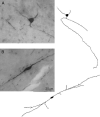Cholecystokinin octapeptide increases spontaneous glutamatergic synaptic transmission to neurons of the nucleus tractus solitarius centralis
- PMID: 16093341
- PMCID: PMC3062488
- DOI: 10.1152/jn.00351.2005
Cholecystokinin octapeptide increases spontaneous glutamatergic synaptic transmission to neurons of the nucleus tractus solitarius centralis
Abstract
Cholecystokinin (CCK) is released from enteroendocrine cells after ingestion of nutrients and induces multiple effects along the gastrointestinal tract, including gastric relaxation and short-term satiety. We used whole cell patch-clamp and immunohistochemical techniques in rat brain stem slices to characterize the effects of CCK. In 45% of the neurons of nucleus tractus solitarius subnucleus centralis (cNTS), perfusion with the sulfated form of CCK (CCK-8s) increased the frequency of spontaneous excitatory currents (sEPSCs) in a concentration-dependent manner (1-300 nM). The threshold for the CCK-8s excitatory effect was 1 nM, the EC(50) was 20 nM, and E(max) was 100 nM. The excitatory effects of CCK-8s were still present when the slices were preincubated with tetrodotoxin or bicuculline or when the recordings were conducted with Cs(+) electrodes. Pretreatment with the CCK-A receptor antagonist, lorglumide (1 microM), antagonized the effects of CCK-8s, whereas perfusion with the CCK-B preferring agonist CCK-8 nonsulfated (CCK-ns, 1 microM) did not affect the frequency of sEPSCs. Similarly, pretreatment with the CCK-B receptor antagonist, triglumide (1 microM), did not prevent the actions of CCK-8s. Although the majority (i.e., 76%) of CCK-8s unresponsive cNTS neurons had a bipolar somata shape and were TH-IR negative, no differences were found in either the morphological or the neurochemical phenotype of cNTS neurons responsive to CCK-8s. Our results suggest that the excitatory effects of CCK-8s on terminals impinging on a subpopulation of cNTS neurons are mediated by CCK-A receptors; these responsive neurons, however, do not have morphological or neurochemical characteristics that automatically distinguish them from nonresponsive neurons.
Figures





Similar articles
-
Vanilloid, purinergic, and CCK receptors activate glutamate release on single neurons of the nucleus tractus solitarius centralis.Am J Physiol Regul Integr Comp Physiol. 2011 Aug;301(2):R394-401. doi: 10.1152/ajpregu.00054.2011. Epub 2011 May 4. Am J Physiol Regul Integr Comp Physiol. 2011. PMID: 21543639 Free PMC article.
-
Effects of cholecystokinin-8s in the nucleus tractus solitarius of vagally deafferented rats.Am J Physiol Regul Integr Comp Physiol. 2007 Mar;292(3):R1092-100. doi: 10.1152/ajpregu.00517.2006. Epub 2006 Nov 22. Am J Physiol Regul Integr Comp Physiol. 2007. PMID: 17122331 Free PMC article.
-
Characterization of neurons of the nucleus tractus solitarius pars centralis.Brain Res. 2005 Aug 9;1052(2):139-46. doi: 10.1016/j.brainres.2005.05.073. Brain Res. 2005. PMID: 16005442 Free PMC article.
-
Cholecystokinin-8s excites identified rat pancreatic-projecting vagal motoneurons.Am J Physiol Gastrointest Liver Physiol. 2007 Aug;293(2):G484-92. doi: 10.1152/ajpgi.00116.2007. Epub 2007 Jun 14. Am J Physiol Gastrointest Liver Physiol. 2007. PMID: 17569742
-
Proopiomelanocortin neurons in nucleus tractus solitarius are activated by visceral afferents: regulation by cholecystokinin and opioids.J Neurosci. 2005 Apr 6;25(14):3578-85. doi: 10.1523/JNEUROSCI.4177-04.2005. J Neurosci. 2005. PMID: 15814788 Free PMC article.
Cited by
-
Effects of acute and chronic nicotine on catecholamine neurons of the nucleus of the solitary tract.Am J Physiol Regul Integr Comp Physiol. 2019 Jan 1;316(1):R38-R49. doi: 10.1152/ajpregu.00344.2017. Epub 2018 Oct 24. Am J Physiol Regul Integr Comp Physiol. 2019. PMID: 30354182 Free PMC article.
-
Roux-en-Y gastric bypass reverses the effects of diet-induced obesity to inhibit the responsiveness of central vagal motoneurones.J Physiol. 2013 May 1;591(9):2357-72. doi: 10.1113/jphysiol.2012.249268. Epub 2013 Mar 4. J Physiol. 2013. PMID: 23459752 Free PMC article.
-
Vanilloid, purinergic, and CCK receptors activate glutamate release on single neurons of the nucleus tractus solitarius centralis.Am J Physiol Regul Integr Comp Physiol. 2011 Aug;301(2):R394-401. doi: 10.1152/ajpregu.00054.2011. Epub 2011 May 4. Am J Physiol Regul Integr Comp Physiol. 2011. PMID: 21543639 Free PMC article.
-
Fibroblast Growth Factor 19 Increases the Excitability of Pre-Motor Glutamatergic Dorsal Vagal Complex Neurons From Hyperglycemic Mice.Front Endocrinol (Lausanne). 2021 Nov 11;12:765359. doi: 10.3389/fendo.2021.765359. eCollection 2021. Front Endocrinol (Lausanne). 2021. PMID: 34858337 Free PMC article.
-
Circulating GLP-1 and CCK-8 reduce food intake by capsaicin-insensitive, nonvagal mechanisms.Am J Physiol Regul Integr Comp Physiol. 2012 Jan 15;302(2):R264-73. doi: 10.1152/ajpregu.00114.2011. Epub 2011 Oct 26. Am J Physiol Regul Integr Comp Physiol. 2012. PMID: 22031786 Free PMC article.
References
-
- Altschuler SM, Bao X, Bieger D, Hopkins DA, Miselis RR. Viscerotopic representation of the upper alimentary tract in the rat: sensory ganglia and nuclei of the solitary and spinal trigeminal tracts. J Comp Neurol. 1989;283:248–268. - PubMed
-
- Andresen MC, Yang M. Non-NMDA receptors mediate sensory afferent synaptic transmission in medial nucleus tractus solitarius. Am J Physiol Heart Circ Physiol. 1990;259:H1307–H1311. - PubMed
-
- Barraco R, El-Ridi M, Parizon M, Bradley D. An atlas of the rat subpostremal nucleus tractus solitarius. Brain Res Bull. 1992;29:703–765. - PubMed
Publication types
MeSH terms
Substances
Grants and funding
LinkOut - more resources
Full Text Sources
Miscellaneous

